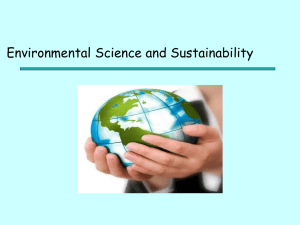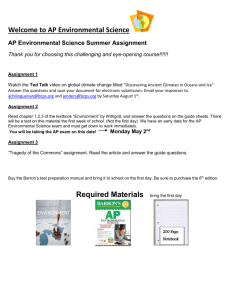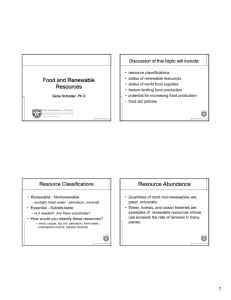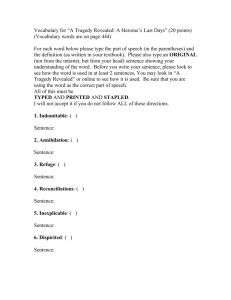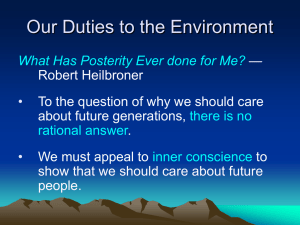The Global Commons:
advertisement
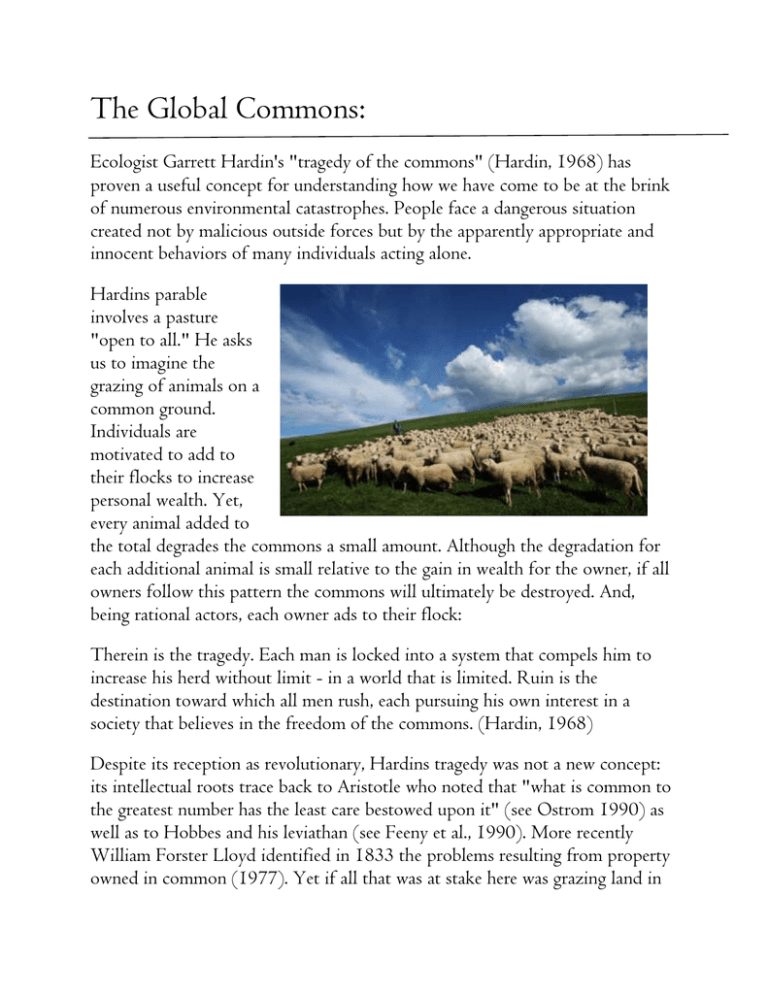
The Global Commons: Ecologist Garrett Hardin's "tragedy of the commons" (Hardin, 1968) has proven a useful concept for understanding how we have come to be at the brink of numerous environmental catastrophes. People face a dangerous situation created not by malicious outside forces but by the apparently appropriate and innocent behaviors of many individuals acting alone. Hardins parable involves a pasture "open to all." He asks us to imagine the grazing of animals on a common ground. Individuals are motivated to add to their flocks to increase personal wealth. Yet, every animal added to the total degrades the commons a small amount. Although the degradation for each additional animal is small relative to the gain in wealth for the owner, if all owners follow this pattern the commons will ultimately be destroyed. And, being rational actors, each owner ads to their flock: Therein is the tragedy. Each man is locked into a system that compels him to increase his herd without limit - in a world that is limited. Ruin is the destination toward which all men rush, each pursuing his own interest in a society that believes in the freedom of the commons. (Hardin, 1968) Despite its reception as revolutionary, Hardins tragedy was not a new concept: its intellectual roots trace back to Aristotle who noted that "what is common to the greatest number has the least care bestowed upon it" (see Ostrom 1990) as well as to Hobbes and his leviathan (see Feeny et al., 1990). More recently William Forster Lloyd identified in 1833 the problems resulting from property owned in common (1977). Yet if all that was at stake here was grazing land in the 1800's this would be an issue for historians alone. Hardin immediately recognized that this concept applies in its broader sense to a great many modern environmental problems (e.g., overgrazing on federal lands, acid precipitation, ocean dumping, atmospheric carbon dioxide discharges, firewood crises in less developed countries, overfishing). Simply stated, we face a serious dilemma - an instance where individual rational behavior (i.e., acting without restraint to maximize personal short-term gain) can cause longrange harm to the environment, others and ultimately oneself. IS THE TRAGEDY INEVITABLE? With a clear definition of a CPR tragedy, researchers have focused on explaining the conditions under which it is most likely to arise. It is noteworthy that not all resource management situations lead to a tragedy. Certain fundamental conditions must exist before a tragedy can emerge. The first condition involves the nature of the resource itself. One must distinguish between a public good and a commons, or what has come to be called a common-pool resource (CPR). Public goods have the attribute of being nonconsumptive. One's use of a public crop forecast does not reduce the availability of that forecast to others. In fact, users of a public good care little about who else uses it. Likewise all users benefit from the maintenance of a public resource (e.g., weather forecasting computer, bridge) whether or not they help pay for the maintenance. Ostrom (1990) has contrasted these attributes of public goods to those of a CPR where the resource is subtractable (one's consumption deprives others of use) and able to be overused. Furthermore, the individuals who contribute to the maintenance of a CPR care enormously about who else is using it and how much they are consuming even if these others help maintain the resource. Yet, not all use of subtractable resources will inevitably lead to catastrophe. The second fundamental condition focuses on access to the resource. A tragedy is more likely to emerge in a situation where restraining access to the resource is costly, impractical or impossible (Feeny et al., 1990). Hardins predictions for the inevitable over-exploitation of a commons were based solely on consideration of open access situations. And in fact case studies document that tragedies do occur when an open-access system supplants a pre-existing successful CPR management system. Thus while a tragedy is not inevitable it is a more likely outcome if one is dealing with a CPR that is subtractable, able to be overused, and experiencing unrestrained, open access. AVERTING THE TRAGEDY Unfortunately, knowing the conditions that lead to a tragedy does not ensure one can easily avoid it. Clearly, the nature of a resource is fixed. While one can limit withdrawal of resource units to a sustainable rate for renewables and a repairable rate for those that physically deteriorate, a subtractable resource cannot be made nonsubtractable. Furthermore, managing access involves the complex task of excluding others from using the resource. Thus averting a tragedy involves restraining both consumption and access Questions: 1) 2) 3) 4) What famous scientist coined the term “Tragedy of the Commons”? Describe Hardin’s parable of a pasture “open to all” Where does the tragedy lie in his parable? Explain Hardin’s theory draws on many classic theories however, what modern environmental problems does his theory apply to today? 5) What is a CPR? Give a few examples of a CPR’ s 6) What is the difference between a CPR and Public Good 7) What is a subtractable CPR? 8) Discuss how these tragedies can be averted in today’s society.
